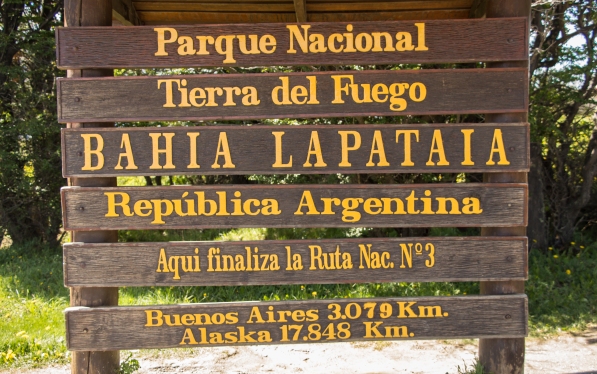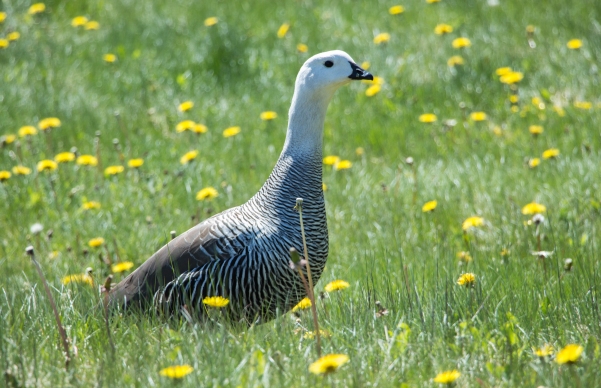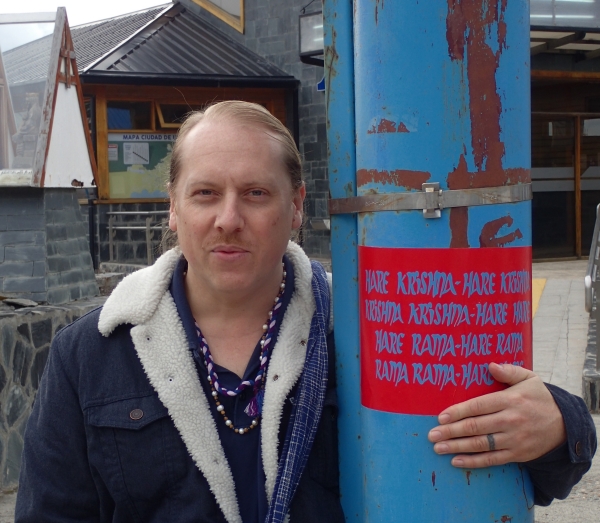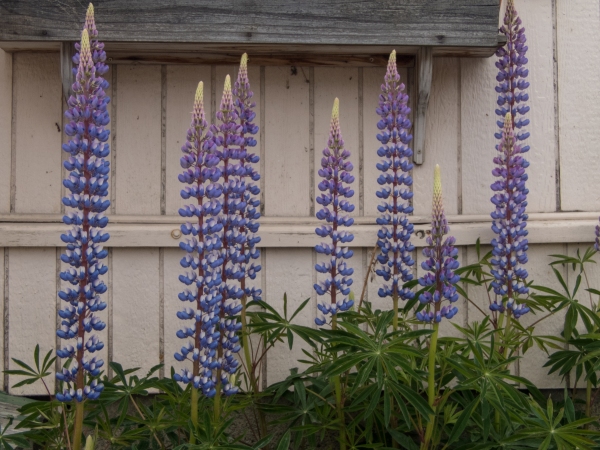November 11-13, 2016: Ushuaia, Tierra del Fuego
After meeting our delightful host, Maria Cristina, who spoke no English (neither Trivikrama nor I spoke a word of Spanish — more about that later), we settled into our cozy room on the ground floor at B&B Nahuel, Calle 25 de Mayo 440. “Nahuel” means jaguar in Mapudungun, an aboriginal language spoken in south-central Chile and west-central Argentina by the Mapuche people. During World War II, Argentina even developed a tank named Nahuel D.L.43, which was the Argentine equivalent to the American medium tanks M4 Sherman and M3 Grant. Due to Argentina remaining neutral during most of WW II and the availability of cheap surplus Sherman tanks after the war, only 12 Nahuel tanks were manufactured in Buenos Aires and supplied to the Argentine Army.

Nahuel B&B, Ushuaia
But, I digress. Once in our room, we liberated Srila Prabhupada from his travelling case and situated him on his vyasasana. The next order of business was for Trivikrama and me to get cleaned up and venture out in search of a vegetarian meal (remember, this was Friday evening and it had been almost two days since we had bathed or had much to eat).

Srila Prabhupada at Nahuel B&B, Ushuaia, Argentina, on November 11, 2016
Argentina, being the beef capital of the world, is not known as a vegetarian haven, what to speak of an out-of-the-way place like Ushuaia. There was only one purely vegetarian restaurant in Ushuaia listed on the Happy Cow website and it wasn’t open evenings or weekends. So we wandered down the main street in town as it began to get dark. A few blocks into our stroll, we were invited by a group of local youth to join in a protest they were staging, complete with Spanish political chants. Envisioning spending time in a South American jail instead of sailing off to Antarctica, we politely declined and continued on our way. Eventually, we found Bodegon Fueguino, a restaurant that had enough vegetarian options (and an owner who spoke enough English to understand our dietary restrictions) to satisfy our desire for a cooked meal. According to the Lonely Planet guide, this is “the spot to sample hearty home-style Patagonian fare.” After dinner, we got a little lost, but finally found our way back to our B&B — safe, sound, and ready for rest.

Knowing that we had until Sunday afternoon in Ushuaia before leaving for Antarctica, I had booked a half-day tour to nearby Tierra del Fuego National Park for Saturday morning. Reserved and prepaid online in advance, the bus was supposed to pick us up at Nahuel B&B by 8:00 AM. Trivikrama and I were ready to go after an early breakfast at 7:30. But, when 8 o’clock came and went, we wanted to confirm that the bus was on its way to get us. We showed Maria Cristina the tour reservation info, which luckily was in both Spanish and English. I, also luckily, had a translation app on my phone, which I used to communicate with her. She called the tour company and was informed that there was a mix up. The bus would not be picking us up and it was leaving soon from the other side of town. They offered to reschedule us for Sunday, but I rejected that idea as too risky (imagining us in a broken down bus on the side of the road, miles from Ushuaia and literally “missing the boat” to Antarctica).

What if we called a cab and high-tailed it over to the bus? Couldn’t they wait a few minutes for us at their last pick up in town? They agreed, sent a message to the bus, and gave us the location. Again, all of this had transpired in Spanish with app-translated input from me and there was bound to be something lost in translation. Still, a taxi came and we drove off. Once “downtown,” it became evident that our driver didn’t exactly know where our bus was supposed to be, but after approaching a couple of other tour buses, we found the right one, just in the nick of time. The tour guide welcomed us aboard and off we went. A few minutes later she came by our seats and reimbursed us for the taxi fare after she called the office and explained what had happened. We were just happy that we hadn’t missed the tour, so the refund was an unexpected, pleasant surprise.

Tierra del Fuego National Park (Parque Nacional Tierra del Fuego in Spanish) is Argentina’s southernmost national park and comprises 240 square miles of Patagonic Forest and Altos Andes ecoregions. The park is studded with mountains, lakes and rivers, which form deep valleys. With Ushuaia to the east, it is bounded on the west by the Chilean border, on the north by Lago Fagnano, and on the south by the Beagle Channel.

The park (and the region) got its name from Spanish explorers in the 1500s: “The first Europeans who came to explore the southern tip of South America saw the campfires of the native inhabitants of the area (the Yaghan people, also called Yámana). The Spanish explorers hence named the area “Tierra del Fuego”, meaning “land of fire” in Spanish.”

Upland (Magellan) Goose in the National Park
Our pleasant visit to the park was breezy and sunny, and provided some beautiful scenery. We learned quite a bit from our knowledgeable guide, including the history of Tierra del Fuego’s beaver problem. In the 1940s, the Argentine government had the bright idea to import 50 Canadian beavers to Tierra del Fuego with the hopes of creating a commercial fur trading industry. Well, the business idea idea failed, but the beavers multiplied and prospered, as there are no natural predators in the region. Recent estimates put the beaver population at between 100,000 and 200,000, which has resulted in extensive damage due to their felling of long-protected trees and creating dams which, in turn, create flooding that harms other trees and vegetation. So now there is a government effort to eradicate, or at least control, the beaver population. Once again, man’s desire to exploit nature and animals results in more suffering and unintended consequences. To counteract all this bad karma, Trivikrama managed to find a suitable place on the back of a park sign to install one of his Hare Krishna maha-mantra stickers.

Back in Ushuaia, Trivikrama and I went to Marco Polo Freelife for lunch and then spent the afternoon exploring the town on foot. We visited the tourist office where we signed the guestbook, and duly recorded our ISKCON 50th anniversary/Krishna South mission to Antarctica. There, we also adorned our passports with the many Ushuaia and Antarctica rubber stamps (Trivikrama made extra copies on post-it notes). Not one to pass up an opportunity to share the Holy Name in his unique way, Trivikrama did some more sticker sankirtan in a prime location where many tourists would pass by and get the mercy.

The tourist office was near the waterfront, where we had our first darshan of MV Ushuaia, our Antarctic expedition vessel. She looked seaworthy enough, although somewhat weathered and whose hull was in need of a paint job. And certainly nothing like the Royal Caribbean luxury ship I experienced on the only other cruise I ever went on from Florida to Mexico with my family, celebrating my mother’s 88th birthday in 2011.

With still a few hours left in the day, Trivikrama and I did some shopping (last-minute supplies for the voyage, some gifts and souvenirs for friends “up north,” etc.). We found a grocery chain store curiously named La Anónima (“The Anonymous”). It was originally known as the Patagonia Import and Export Company, but due to the extension of the company’s territory and the complexity of the name, the inhabitants of Patagonia called the stores simply “The Anonymous.” The name stuck and it was eventually adopted as the official name for all their stores (now, over 150 stores in 80 cities throughout Argentina). One inspired purchase there was a supply of nuts and dried fruits to offer to Srila Prabhupada on the voyage.

Another store we visited was Piedras Argentinas, where we bought items (penguin jewelry and figurines) made from native Argentine stone such as rhodochrosite (the “national gemstone”), opalina (from Cordoba), and black onyx (from Ushuaia). Trivikrama, originally from New York, haggled with the Russian store manager for quite some time, but eventually got her to give him a deep discount on the gift he picked out for his mother. Then, we were off to Bodegon Fueguino for another well-prepared Patagonian vegetarian dinner before returning to Nahuel B&B for the night.

The next morning . . . Sunday, November 13th, 2016 — at long last, our Antarctica voyage departure day had arrived! After breakfast, Trivikrama and I went for a japa walk around Ushuaia (fin del mundo), the end of the world. Since, in a few short hours, we would be leaving the terra firma of South America behind and not setting foot on land again until reaching the terra incognita of Antarctica, it was, for us, the end of the world as we knew it.

Following some back-and-forth, “should we or shouldn’t we?” discussions, we ultimately decided to take a tour on the Ushuaia City Train (after all, what was the likelihood that we’d ever visit Ushuaia again?). On the tour, which included a recorded narration in Spanish and English (and punctuated by 1970s American and British rock classics), we learned that for the first half of the 20th century Ushuaia was centered around its prison (hence the above prisoner and guard motif).

Ushuaia is the provincial capital and administrative center for Tierra del Fuego, Antarctica and the South Atlantic Islands (Tierra del Fuego, Antártida e Islas del Atlántico Sur). It is also a light industrial port and tourist hub. Ushuaia’s importance for us was its proximity to the Antarctic Peninsula, our Krishna South destination, and that our ship was named the MV Ushuaia.

A view of Ushuaia from the tour
After the tour, Trivikrama and I went down to the taxi stand near the port to arrange for a vehicle to pick us up at Nahuel B&B and take us to the dock later that afternoon. We wanted to make sure we reserved a large taxi that could handle the volume of our luggage. As we walked up the hill to our room, we got another view of MV Ushuaia from a different perspective.

MV Ushuaia docked in Ushuaia
While Trivikrama stayed in the room to rest and repack, I took a final walk around town to snap a few photos and to get a couple of takeaway lunches from Marco Polo Freelife. November is springtime in Ushuaia and I saw quite a few varieties of flowers in bloom, in addition to the ubiquitous dandelions, which didn’t seem to be treated as weeds there (someone even called the dandelion “the official flower of Ushuaia” on a travel website).

Lupines (I think)
Apparently, dogs getting into the garbage is a problem in Ushuaia and I observed all manner of elevated cage-like structures in front of many houses and businesses. The one pictured below was one of the more elegant designs.

Although we didn’t run into any Hare Krishna devotees distributing books in Ushuaia, I did meet a couple of Jehovah’s Witnesses from Buenos Aires who had set up their literature display on the main drag. I took this chance meeting as a reminder that Trivikrama and I were also on a “mission from God (Krishna).”

“All Along the Watchtower” with Jehovah’s Witnesses in Ushuaia
Note about the blog posting dates: They’re bogus! In order for the chapters to appear in chronological order, I have to back date them in reverse order. Go figure . . .


Do u think the Yamanas come from yavanas?
LikeLike
Could be, since yavanas can refer to meat-eaters, in general. They are mentioned in the Bhagavatam and Mahabharata and sometimes connected to Greece and Turkey. And in some Buddhist literature, yavana and yamana were used interchangeably to refer the island kingdom of Java (Indonesia).
LikeLike